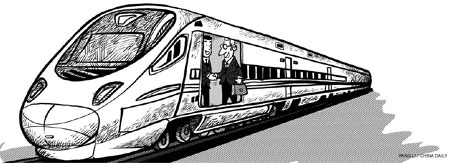China pivotal to Australia's success

Nearly half a century ago, Geoffrey Blainey's The Tyranny of Distance argued that Australia's geographic position shaped Australians' psychological attitudes. The long distance between Australia and its colonial forebears in Europe, and also the United States, made Australians unsure of their future economic prosperity.
Around the time Blainey was writing, Donald Horne's The Lucky Country described a resource-rich Australia that lacked intellectual confidence and the capacity to make the most of its natural endowments. Horne said a reluctance to engage with Asia would harm Australia politically, socially and eventually economically. Noting this reluctance, Singapore's former prime minister Lee Kuan Yew famously warned that Australia risked becoming the "poor white trash of Asia" and advised that vast natural mineral wealth was neither necessary nor sufficient for long-term prosperity.
In these years, however, Japan had already succeeded the United Kingdom as Australia's major trading partner, and the Australian economy had begun its long journey toward greater engagement with the Asia-Pacific region. In 1957, just 12 years after the end of World War II, John McEwen, then Australian trade minister, signed a commercial agreement with Japan. This agreement gave Australia a "beachhead" in Asia, and launched the Australian tradition of bipartisan support for increased trade engagement with the region.
There followed a flurry of trade and, later, investment activities between Japan and Australia. Transforming itself from a nation devastated by war into a huge and affluent economy, Japan had surpassed the UK as Australia's trading partner by 1966. And Japan's re-entry into the world economy was followed closely by South Korea and the other "Asian Tigers".
During that time, China remained closed to the rest of the world with little economic engagement outside its borders. Australian relations with China warmed dramatically after Gough Whitlam visited Beijing as leader of the Australian opposition in 1971 and formally established diplomatic relations after being elected Australian prime minister in 1972. This early development and Australia's support for China's entry into the World Trade Organization show that Canberra regards Beijing as a key economic partner. China has now overtaken Japan as Australia's top trading partner.
If the past 40-50 years have been about Japan and the Asian Tigers, the next phase of Australia's engagement in the "Asian century" will be largely about China, followed by India, member states of the Association of Southeast Asian Nations and the economies of emerging Asia.
It is, however, not surprising to see China as Australia's top export destination and source of imports, and a key source of overseas students and tourists. The flow of investment is improving both ways and Australian brands are becoming more widespread in China.
While Australia's large enterprises have already formed strong relationships in Asia, with Rio Tinto, ANZ, BHP Billiton, Rheem, Bluescope, Elders and Woodside being very familiar with the Chinese business landscape, the nature of global supply chains and open regionalism means that Australian small and medium-sized enterprises (SMEs) will become increasingly engaged in overseas trade.
These SMEs are joining global supply chains, engaging in strategic alliances and joint ventures, and setting up franchises across the region. New research by Sensis shows that for Australian SMEs engaged in exports, China is the fifth largest destination - after ASEAN and the traditional English-speaking markets of New Zealand, the United States and the UK.
Australia's first engagement with China has been focused on "rocks and crops" (mining and agriculture), steel and iron ore, and pumping liquefied natural gas offshore to the region. But now services will play a more important role in bilateral trade despite facing some significant competitive challenges.
"Rocks and crops" will continue to provide the lion's share of Australia's export revenue to China - but its "points of engagement" with Asia will expand as services trade promotes broader and deeper people-to-people relationships.
Services complement the role that "rocks and crops" and advanced manufactures play in Australia's trade; they are not a substitute for (or alternative to) them. Exports of goods build a platform that enables services trade to grow throughout the region and bring with it opportunities for investment, niches for SMEs, and richer global and regional integration.
So what is the future of Sino-Australian economic relations? While "rocks and crops" will dominate, services and education ties are expected to grow and prosper. More action for Australians in western China can also be expected.
Recently, I taught an MBA course in Chengdu in southwestern China. There we met Clint Wood, of Place Design, building landscape properties for Chengdu's burgeoning middle class, and visited the Rheem joint venture just outside the city. Western China needs roads, airports, civic buildings and schools. So there's plenty of opportunity for Australian architects, designers, construction companies and anyone with skills to build western China's physical and social infrastructure.
The urbanization of China is the story of the 21st century, and Australia will do its bit to help feed, clothe, energize, design, build for and educate China's growing urban population - particularly in the west.
Australia's economic ties with Asia have gone through many twists and turns, as the countries in the region have grappled with the tyranny of distance and the changing economic landscape. Australia began its engagement with Asia with post-war trade relations with Japan and the recognition of China in 1972 - and then by transforming its domestic structure in the 1980s and 1990s to become one of the world's most open and successful economies. Now, Australia embarks with cautious optimism on a new phase.
There are some early positive signs from Australia's new wave of engagement with the region - signs that Australians are really starting to benefit from the power of proximity in the "Asian century" - with China at the forefront.
The author is the JW Nevile Fellow in Economics at the Australian School of Business, University of New South Wales, and author of The Airport Economist.


















